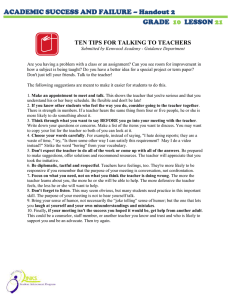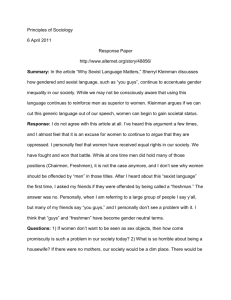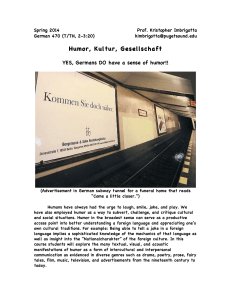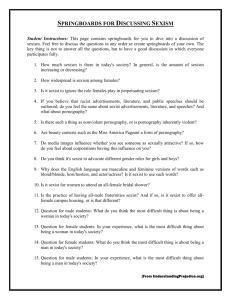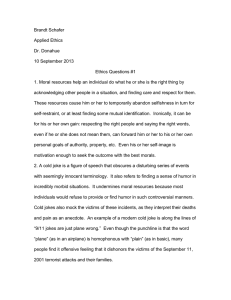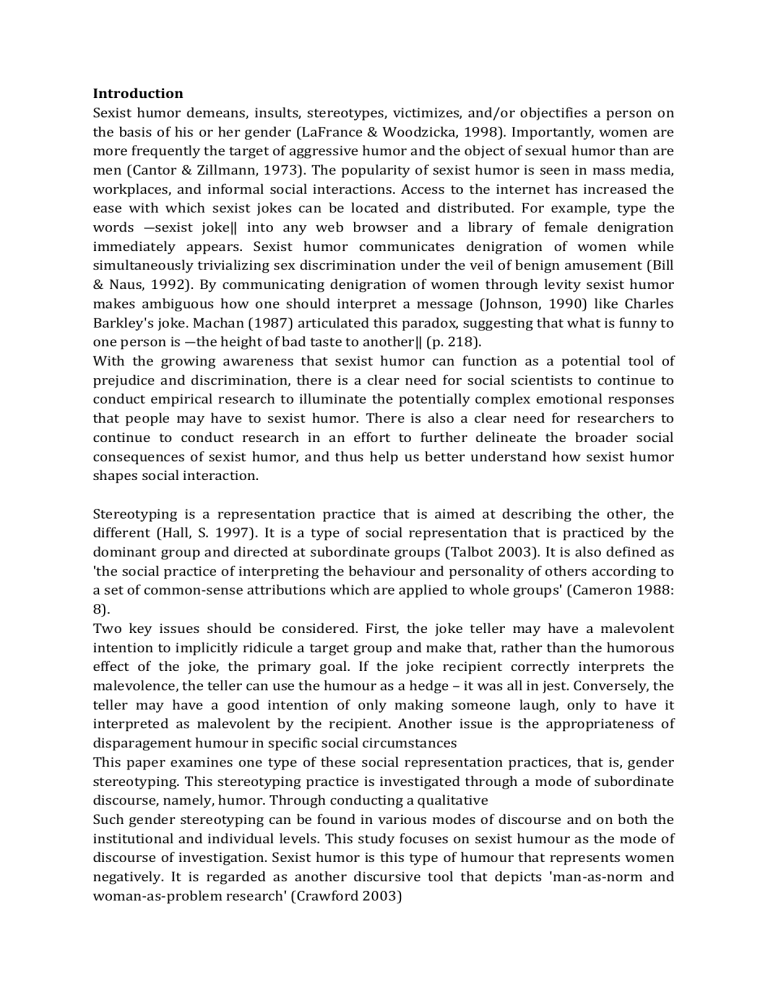
Introduction Sexist humor demeans, insults, stereotypes, victimizes, and/or objectifies a person on the basis of his or her gender (LaFrance & Woodzicka, 1998). Importantly, women are more frequently the target of aggressive humor and the object of sexual humor than are men (Cantor & Zillmann, 1973). The popularity of sexist humor is seen in mass media, workplaces, and informal social interactions. Access to the internet has increased the ease with which sexist jokes can be located and distributed. For example, type the words ―sexist joke‖ into any web browser and a library of female denigration immediately appears. Sexist humor communicates denigration of women while simultaneously trivializing sex discrimination under the veil of benign amusement (Bill & Naus, 1992). By communicating denigration of women through levity sexist humor makes ambiguous how one should interpret a message (Johnson, 1990) like Charles Barkley's joke. Machan (1987) articulated this paradox, suggesting that what is funny to one person is ―the height of bad taste to another‖ (p. 218). With the growing awareness that sexist humor can function as a potential tool of prejudice and discrimination, there is a clear need for social scientists to continue to conduct empirical research to illuminate the potentially complex emotional responses that people may have to sexist humor. There is also a clear need for researchers to continue to conduct research in an effort to further delineate the broader social consequences of sexist humor, and thus help us better understand how sexist humor shapes social interaction. Stereotyping is a representation practice that is aimed at describing the other, the different (Hall, S. 1997). It is a type of social representation that is practiced by the dominant group and directed at subordinate groups (Talbot 2003). It is also defined as 'the social practice of interpreting the behaviour and personality of others according to a set of common-sense attributions which are applied to whole groups' (Cameron 1988: 8). Two key issues should be considered. First, the joke teller may have a malevolent intention to implicitly ridicule a target group and make that, rather than the humorous effect of the joke, the primary goal. If the joke recipient correctly interprets the malevolence, the teller can use the humour as a hedge – it was all in jest. Conversely, the teller may have a good intention of only making someone laugh, only to have it interpreted as malevolent by the recipient. Another issue is the appropriateness of disparagement humour in specific social circumstances This paper examines one type of these social representation practices, that is, gender stereotyping. This stereotyping practice is investigated through a mode of subordinate discourse, namely, humor. Through conducting a qualitative Such gender stereotyping can be found in various modes of discourse and on both the institutional and individual levels. This study focuses on sexist humour as the mode of discourse of investigation. Sexist humor is this type of humour that represents women negatively. It is regarded as another discursive tool that depicts 'man-as-norm and woman-as-problem research' (Crawford 2003) A descriptive comparison between a source and target text will not see humor as a homogeneous category (“that what caused laughter”) but will study its specific cognitive, emotional, social and interpersonal aspects (Vandaele 2002). s. I have looked at the topic of humour, especially its darker side, and suggested that ridicule plays a central role in social life (Billig, 2001a). I have also been investigating the humour of extreme bigotry (Billig, 2001b, 2002). This work is at a comparatively early stage, but I hope eventually to connect it with my earlier reinterpretation of Freud. Ford and Ferguson's (2004) prejudiced norm theory consists of four propositions that delineate the mechanisms by which sexist humor encourages the expression of prejudice against women. First, humor activates a conversational rule of levity, to switch from the usual literal, serious mindset for interpreting a message to a noncritical "humor mindset" that trivializes its subject (Berlyne, 1972; McGhee, 1972). Thus, sexist humor communicates an implicit meta-message (Attardo, 1993) that, in this context, one can treat discrimination in a less serious, more lighthearted manner. Ford (2000) found that sexist humor increased tolerance of a sexist event, and this effect was attenuated when participants were instructed to interpret the humor as they would a serious, non-humorous message. since sexist people are especially likely to interpret sexist humor in a noncritical humor mindset, they are more likely to perceive and assent to an emergent prejudiced norm in the immediate social context, and use that norm to guide their own responses toward women (Ford & Ferguson, 2004; Viki, Thomae, Cullen & Fernandez, 2007; Viki, Thomae & Hamid, 2006). Viki et al. (2006) Sexist humor derives power to foster expressions of prejudice against women from the ambivalence of society's attitudes toward women (Ford, Triplett, Woodzicka, Kochersberger, & Holden, 2013). System justification theory proposes that people are motivated to defend the status quo in society, including social inequalities (Jost, Banaji, & Nosek. 2004; Napier, Thorisdottir & Jost, 2010). Perceiving existing social arrangements as just or legitimate minimizes uncertainty and threat (Napier et al., 2010). LITERATURE REVIEW Humour Types of Humour Theories of Humour Humour linguistics Humour pragmatics Gender and Humour Superiority vs Inferiority of gender through humour o Superiority theories are directly associated with disparagement. The idea that someone else‟s misfortune makes people laugh is as old as Plato and Aristotle, although most proponents of superiority theories refer to Thomas Hobbes, according to whom “the passion of laughter is nothing else but a sudden glory arising from sudden conception of some eminency in ourselves, by comparison with the infirmities of others, or with our own formerly”( The current investigation relied largely on Social Constructionism and assumed that words and images do not have any inherent meanings of their own instead, meanings are activelyconstructed by individuals and societies and that these meanings are more context specific rather than universal. Following this instance, all memes; their text and images were viewed as having strong socially created meanings which speak volumes about the socio-cultural context they are constructed in. Another theoretical framework on which this work is based describes sexist humour as ‘more than just a joke’ which, in the long run, can even cultivate and foster sexist attitudes. Ford et al. (2008) suggest that sexist humour is a subtle expression of gender related biases which they aptly call ‘The prejudice-releasing function of sexist humour’. Looking from this vanta ge point, the current study views sexist memes as more than spontaneous jokes,with immense potential of promoting sexist attitudes. Research Questions How gender inequality and masculine hegemony is created through humour in Pakistani patriarchal society What male stereotypes are created through humour in Pakistani society system What female stereotypes are created through humour in Pakistani society system METHODOLOGY The study employs the General Theory of Verbal Humour (GTVH) by Attardo & Raskin (1991) as theoretical framework. Twenty jokes have been selected purposively in which either women are present or are the subject in their absentia. Mostly jokes have been picked from social media such a Facebook’s page Lateefay hi Lateefay, while a few have been taken from Whatsapp group chats in which such jokes had been shared by friends. They have then been analysed on the basis of the GTVH's six knowledge resources (KRs): (i) script opposition, (ii) logical mechanism, (iii) situation, (iv) target, (v) narrative strategy, and (vi) language. The jokes about popular female figures have not been included as they are mostly recycled from general jokes about women. Moreover, this study specifically focuses upon the representation of common women in different spheres that is why jokes have been divided into four different themes: Representation of women in general, Women exercising skills/intellect, Women as life partners and representation of teenage girls/young women. Finally Linguistics based jokes rely upon the exploitation of the linguistic resources to generate humorous effect (Servaitė, 2005) but here all the jokes have been translated from Urdu to English that is why their funniness is not caused by linguistic manipulation rather due to their content. Sample For the purpose of this study, sexist memes were searched online with certain keywords viz. “Sexist memes”, “Viral sexist memes” and “Indian sexist memes”. From the results yielded by Google.com, more than 100 images were extracted arbitrarily. Each of these images were, then, tested against the inclusion criteria i.e. (a) presence of textual and pictorial content, (b) Content (text and/or images) that explicitly or implicitly demeans, belittles or mocks a specific gender and (c) humour. In order to meet the latter two inclusion criteria, each meme was rated by the three researchers as either “Sexist” or “Not sexist” and “Humorous” or “Not humorous”. The shortlisted memes were the ones that were rated as “Sexist” and “Humorous”unanimously by all three researchers. Thus, out of the initial 100 memes chosen arbitrarily, 70 were selected purposively (with inter-rater agreement) for further analysis. In order to ensure data saturation, ten more memes were included in the analysis and therefore, the total number of memes that were analysed was 50. After all surfacing themes were arranged, the next step involved grouping these themes into broad categories, which resulted in three categories namely, ‘Dominance of patriarchy’. ‘Gender stereotypes’ and ‘Women as manipulators’. Again, clustering of themes and their assignment to overarching categories was based on inter-rater agreement.At this stage too, some of the themes were either dropped as they could not fit into any category or were unified into one themedue to excessive overlap or commonalities.Afterwards, each category and its corresponding themes were analysed and discussed in light of existing theories. Data analysis Since the primary objective of our study was to explore how humour can increase the acceptability and tolerance of sexism, we focused mainly on the content of sexist memes and the ways in which sexism is manifested therewith. A combination of quantitative and qualitative content analysis was applied fordata analysis. The initial phase employed quantitative content analysis wherein the frequencies of ‘Adjectives’ used for women, in the selected sexist memes, were counted. This was followed by a more indepth qualitative analysis which involved the interpretation of both textual as well as pictorial contents of these memes. Qualitative content analysis involved Mayring’s (2000) three step Inductive Category Development approach which includes(1) Theme identification, (2) Clustering themes into overarching categories and (3) Interpretation. In the first stage emergent themes were identified. It is worth noting here that both explicit (Emerging from text) as well as implicit (Emerging from background images)themes were picked at this stage. The general theory of verbal humor (GTVH) was proposed by Victor Raskin and Salvatore Attardo in the article "Script theory revis(it)ed: joke similarity and joke representation model".[33] It integrated Raskin's ideas of Script Opposition (SO), developed in his Script-based Semantic Theory of Humor [SSTH], into the GTVH as one of six levels of independent Knowledge Resources (KRs).[34][35] These KRs could be used to model individual verbal jokes as well as analyze the degree of similarity or difference between them. The Knowledge Resources proposed in this theory are:[36] 1. Script opposition (SO) references the script opposition included in Raskin's SSTH. This includes, among others, themes such as real (unreal), actual (non-actual), normal (abnormal), possible (impossible). 2. Logical mechanism (LM) refers to the mechanism which connects the different scripts in the joke. These can range from a simple verbal technique like a pun to more complex LMs such as faulty logic or false analogies. 3. Situation (SI) can include objects, activities, instruments, props needed to tell the story. 4. Target (TA) identifies the actor(s) who become the "butt" of the joke. This labeling serves to develop and solidify stereotypes of ethnic groups, professions, etc. 5. Narrative strategy (NS) addresses the narrative format of the joke, as either a simple narrative, a dialogue, or a riddle. It attempts to classify the different genres and subgenres of verbal humor. In a subsequent study Attardo expands the NS to include oral and printed humorous narratives of any length, not just jokes.[37] 6. Language (LA) "...contains all the information necessary for the verbalization of a text. It is responsible for the exact wording ...and for the placement of the functional elements."[38]

